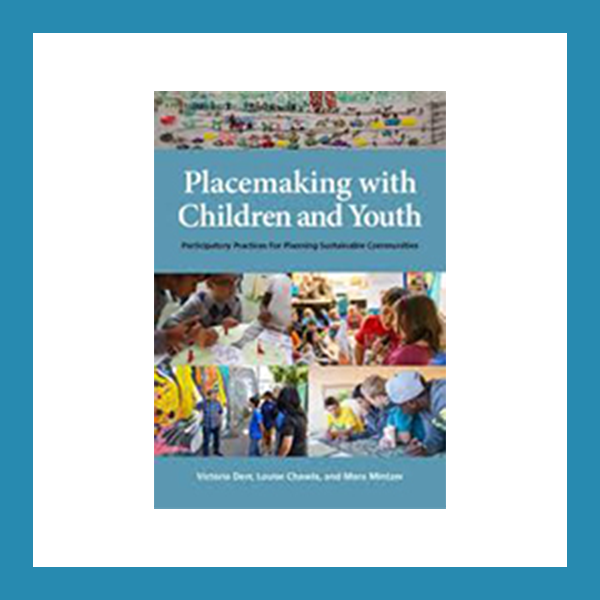Book Review: Placemaking with children and youth: Participatory strategies for planning sustainable communities
Author Note
Derr, V., Chawla, L., and Mintzer, M. (2018). Placemaking with children and youth: Participatory strategies for planning sustainable communities. New York: New Village Press, as reviewed by Brandy C. Judkins, educator with Cobb County School District, Marietta, Georgia, and doctoral graduate of University of Nebraska, Lincoln, Teaching, Learning, and Teacher Education.
Correspondence regarding this book review should be addressed to Brandy C. Judkins at Brandy.Judkins@cobbk12.org or bjudkins2@unl.edu.

Place. It is more than where. More than what. More than whom. It is the heart of living and learning. No human can escape the built environment, as our species is surrounded and often defined by the structures and complexities that have been developed to replace, tame, embrace, or compensate for the natural world outside. Yet, barriers to engagement with design and development exist for many people, especially children and youth. These barriers prevent the design and development of built environments that embody the needs, desires, and interests of all who live within the built environment. For example, schools are inhabited by children for over eight hours a day 180 days a year. However, are schools designed and developed with the interests and ideas of children in mind? Or, are they designed and developed with the interests and ideas of adults?
The answer, as the reader will have little doubt after reading this unique and important textbook, is the latter, not the former. Our spaces, our very built environment, are generally designed and developed by and for adults, not children. It is into this gap that Derr, Chawla, and Minzer seek to shed light and change discourse by instructing current and future city planners, architects, industrial and interior designers, interior decorators, landscape architects, contractors, government officials, and educators in engaging the children and youths of their communities in design, decision-making, and development to create truly sustainable communities that meet the needs of all who live within them.
Divided into twelve chapters, Placemaking with children and youth: Participatory strategies for planning sustainable communities presents a history of children’s rights focused on the United Nations Convention on the Rights of the Child and global case studies of efforts to create communities and structures that embrace and empower children in Australia, South America, the United States, Canada, India, and New Zealand. Each chapter walks the reader through an intentional process of facilitating participatory design with children and youths.
The foreword, orientation section, and chapter one serve as an introduction to the focus of this instructional text. The focus being on the framework of participation, the contexts of urban planning, the methods of participation discussed through the case studies, and the authors’ endorsement of reculturing urban planning. Chapters two through four introduce readers to the first step of any intentional practice-empathy building through working to understand and listen to who and what one is working with. Chapters five through seven discuss different approaches to engaging children and youth. Chapter five introduces a variety of artistic modes of engagement from murals to role-playing to narrative building. Chapter six presents over seven approaches to seeking out information from children and youths–interviews, focus groups, and surveys included. Chapter seven introduces the reader to thinking through the built environment through the eyes and experiences, not just opinions, of children and youths. This chapter discusses using child-led tours, mapping techniques, and innovative uses of technology. Chapters eight and nine move the reader from seeking out information to engaging children in planning. Chapter eight discusses child and youth participation in or control of planning and marketing of projects, while chapter nine discusses analyzing and reporting on projects with and to children and youths. Chapter ten builds on the prior chapters by discussing the evaluation and reflection stage both with and without children and youth. This chapter, in particular, is essential for the presented process to remain intentional–as long as stakeholders are fully engaged not just outside adjudicators. The text ends on a positive note, with chapter eleven providing additional advice and examples of effective and innovative projects and chapter twelve reiterating the principles the authors expose throughout the text: that projects must be local and place-based, transparent, inclusive, relevant, educational for all, sustainable, voluntary, and, uniquely and importantly for the authors, playful.
Figures, images, and diagrams are used throughout the text to complement the case study examples, framework, and advice. Placemaking with children and youth: Participatory strategies for planning sustainable communities remains focused on encouraging the reader to do this work in his or her own communities and helping him or her better visualize how that is possible. The strengths of the text are the hopeful tone that carries throughout the text, the clear focus on action not solely theory, and the direct examples presented via case studies. Ultimately, Derr, Chawla, and Mintzer shed light on a true gap in urban and space planning. Children and youth are not just the future, in that they will grow into the inheritors of the earth but are also living stakeholders of their communities. Their interests, needs, and desires must be considered and embraced, not forgotten or assumed by adults, if the built environment is to be recultured into sustainability.
Viewed through the lens of an educator with an interest in place-based education, this text has true potential to spark new and different conversations among future and current planners, designers, leaders, and educators. The potential to encourage innovative projects hand-in-hand with children and youths makes it appropriate for today’s university classrooms. The only missing piece? A future edition with more stories from and by children and youths and the adults doing this work with them.
Author

Brandy C. Judkins is an educator in Georgia. She completed her doctoral studies in educational studies at the University of Nebraska-Lincoln in 2018, after masters work at Georgia State University in applied linguistics. Her research has focused on the intersections between academic language, making, and design thinking and on the preparation of teachers and administrators to serve the diverse populations in 21st century schools and beyond. She currently resides in Marietta, Georgia, teaching middle school students in one of the largest suburban school districts in the US. She is active in a number of professional organizations, particularly the Association of Teacher Educators, TESOL International, the Council for Exceptional Children, and the Professional Association of Georgia Educators. Outside of research and teaching, she is an active advocate for public education and English language learners, an avid reader, and an architecture and design buff. In partnership with Stand for Schools, she created the first March for Public Education in Nebraska. The daughter of a veteran master educator, her passion is to foster and empower both the art and the science of teaching.

